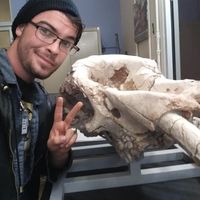Prehistoric Archaeological Site in the Negev Desert of Israel Reveals a Taste For Ostrich Eggs
Archaeologists working in the rugged Negev Desert in Southern Israel have made an exciting discovery among the Nitzana dunes. This region lines the Israeli-Egyptian border and continues yielding important archaeological discoveries highlighting the breadth of historical human geography and movement. They discovered the remains of a campsite that dates from between 4,000-7,500 years ago. This discovery sheds light on how ancient peoples prepared their breakfast and possible evidence for the domestication of the ostrich. The team discovered a hearth or fire pit feature while performing subsurface testing. The hearth contained multiple examples of ostrich eggshells that appeared to have been used for culinary purposes by the group occupying the campsite. It is worth noting that the egg remains are in excellent condition and will certainly provide fascinating results when evaluated.
Zooarchaeology is the study of faunal (animal) remains present in archaeological sites. This subfield of archaeology is responsible for much of our collective knowledge of everything from prehistoric diets to animal domestication. The data collected by these researchers can lead to fascinating revelations that expand our understanding of humanity’s connection with the animal kingdom. One such example is the discovery of the domestication and trade of turkeys across the American southwest by complex indigenous societies like those who lived in Mesa Verde and Chaco Canyon. Through DNA and faunal analysis, Zooarchaeological researchers discovered a direct link between the wild, now considered feral, turkeys of the American West and these domesticated turkeys.
This is just one of the countless examples of the prolific data that faunal remains provide to the archaeological record. An archaeological site is defined as anywhere a human did something in the past. This is why context is so crucial when evaluating archaeological sites. As human technology progressed, the materials we left at those sites changed. This is why it is so important to evaluate hearth features that give us direct insight into the daily lives of ancient peoples.
Zooarchaeologists are currently evaluating this discovery to extrapolate all necessary data to understand this ancient group’s relationship with ostriches. Lithic artifacts like flint stone tools were also recovered from the site alongside ceramic pottery sherds, suggesting that this group likely practiced a form of “tethered mobility,” which means seasonal nomadic movements to different areas in a region. A total of 8 ostrich eggs were discovered at this site. Wild ostriches were known to inhabit the region for up to the 19th century, so these eggs could have been looted from nests, perhaps hinting at a seasonal subsistence strategy.
Source: Phys.org, Archaeology Magazine, University of Tennessee, Knoxville









